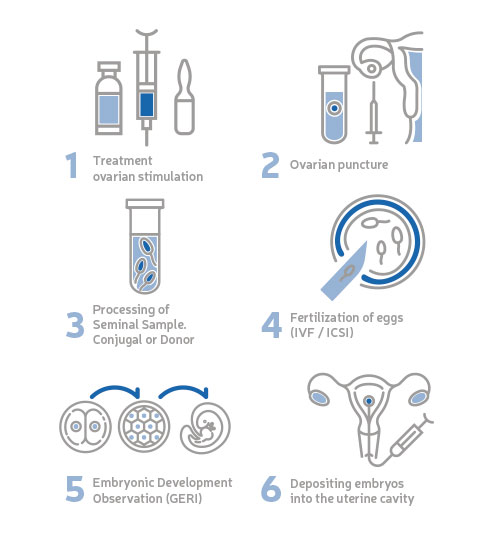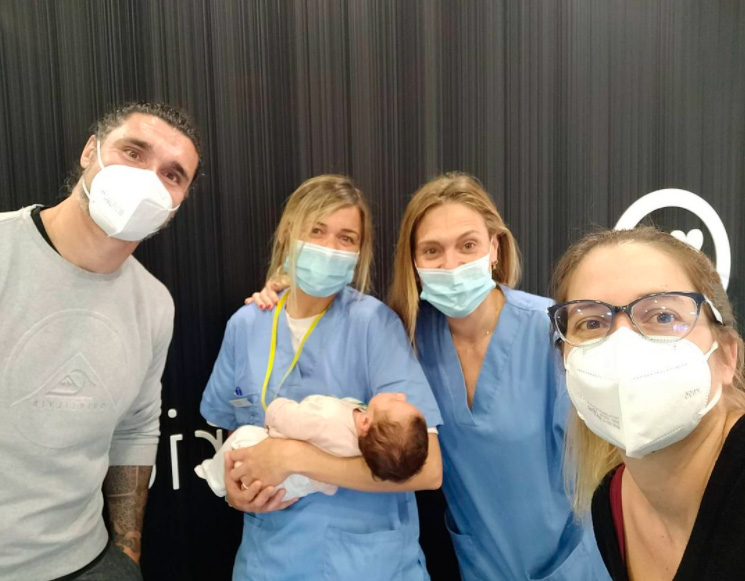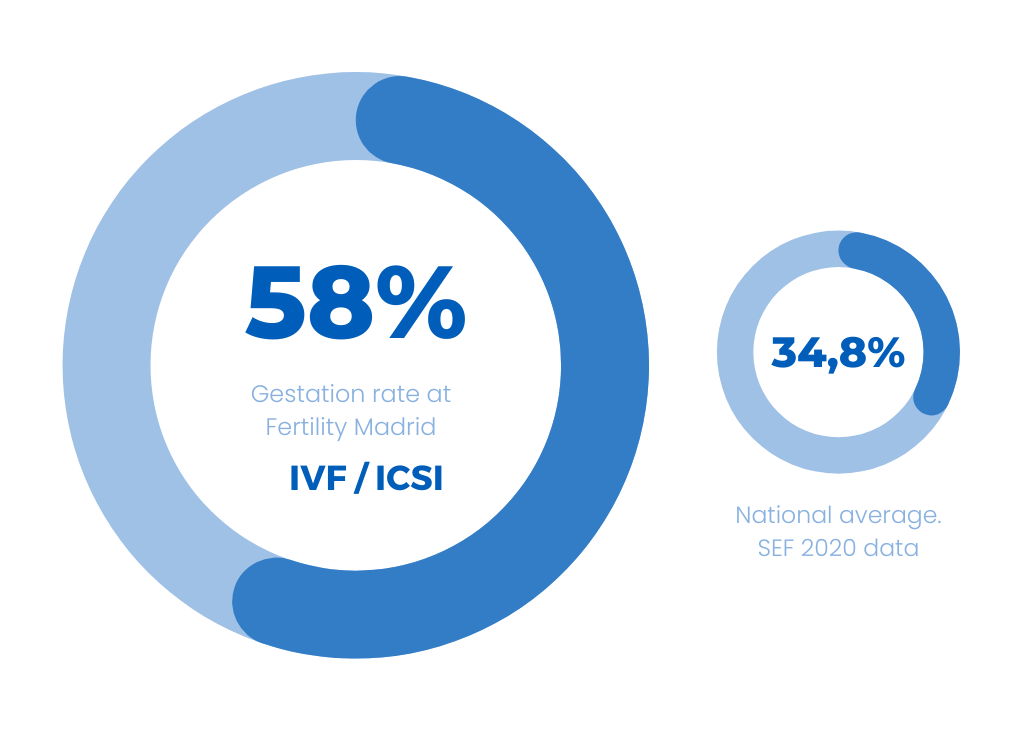What is IVF?
In Vitro Fertilization is the union between the egg and the spermatozoon in a dish at the laboratory in order to obtain inseminated embryos to be transferred back into the woman’s uterus.
It is necessary to do a follicle tap to extract some eggs and to treat the semen sample for it to be of use.
In vitro fecundation can be carried out through any of two different processes: the conventional in vitro fecundation or IVF, where egg and spermatozoon join spontaneously at the laboratory; and the Intracytoplasmic Sperm Injection or ICSI, where the fecundation is carried out by injecting a spermatozoon in each egg.
In what cases is In Vitro Fertilization indicated?
In Vitro Fertilization (IVF) is mainly intended for the following cases:
- Women who have a blockage in their fallopian tubes
- Women experiencing alterations in their ovulation
- Women who wish to have children without a partner
- Women affected by the disorder of endometriosis
- Men with low quality in both quantity and quality of their sperm
- Infertile men or those who have undergone vasectomy
- Homosexual couples wishing to have children
- Couples with some degree of sterility of unknown origin
IVF process and how it works
Before undergoing IVF treatment, it is necessary to determine the appropriate technique for each patient, that is, to analyze whether IVF will be performed with the patient’s own eggs and partner’s sperm or if donors will be needed.
At Fertility Madrid, we study each patient’s case and tailor the treatment to their situation.
Once we have analyzed the most suitable process for the patient, the treatment begins following these steps:
In Vitro Fertilization Process
The first step of the treatment is to choose the technique that best suits the patient’s needs. Currently there are 4 possible In Vitro Fertilization treatments:
- La FIV with own eggs and partner’s semen
- FIV with own eggs and donor semen.
- FIV with donor eggs and partner’s semen.
- Double donation.
Ovarian stimulation involves using hormonal medications to achieve multiple follicular ovulation.
Naturally women mature a single oocyte. However, with medication the goal is to develop several antral follicles to obtain more mature eggs.
Follicular puncture will be performed in the operating room under sedation. It is a very simple procedure, which consists of aspirating the antral follicles to obtain the oocytes.
Upon reaching the in vitro fertilization laboratory will arrive tubes containing follicular fluid where the embryologist must locate the oocytes.
On the same day as the follicular puncture, the seminal sample (partner’s or donor’s) will be capacitated. On this same day (day 0) in vitro fertilization will be performed which is the union of the egg with the sperm.
In vitro fertilization can be performed by two different procedures:
- Conventional In Vitro Fertilization, in which the egg and sperm spontaneously unite in the laboratory
- Sperm Microinjection or ICSI, in which fertilization is achieved by injecting a sperm into each egg.
After the fertilization of the gametes, the embryonic culture will begin which at Fertility Madrid will be done in the GERI Time-Lapse incubator.
This way, we won’t have to remove the embryos from the microscope to evaluate them, since the incubator takes photos every 5 minutes, generating a Time-Lapse movie.
In addition, embryonic culture is carried out in individual compartments for each patient. The embryos will be in the incubator between 3 and 6 days depending on each case.
Once embryos of good quality have been selected, embryo transfer or vitrification of these will be carried out.
The transfer is performed in the operating room, not because of the complexity of the technique itself but because of its proximity to the laboratory. In this way we try to alter the embryonic development as little as possible. The transfer consists of introducing the embryo or embryos obtained into the uterus.
The current Spanish legislation allows transferring up to 3 embryos. We in our clinic will never do it, at most we will transfer two embryos. For this, the gynecologist must give consent to the woman, so that she can carry out a twin pregnancy without complications for herself or for the babies.
Once the doctor approves the transfer of two embryos, couples have to assume the risk of a twin pregnancy. If the couple assumes the risk, we will transfer two embryos. If not, we will always try to transfer a single embryo in order to reduce multiple births.
Sometimes, all the embryos generated or the “leftovers” will be vitrified. This way, we stop the biological clock. These can be used in subsequent cycles without the need to go through ovarian stimulation again.
In this case, the only thing we would do is prepare the endometrium of our patient.

Types of in vitro Fecundation
In vitro fecundation with patient’s partner semen is recommended in the following cases:
- Fallopian tube obstruction.
- Ovulation alteration.
- Women suffering from endometriosis.
- When defects regarding speermatozoons quantity or quality exist.
- Sterility of unknown origin.
- Failure of previous treatments such as artificial insemination.
- Couples who had permanent birth control procedure done (tubal ligation and/or vasectomy).
In vitro fecundation with a donor’s semen is recommended in the following cases:
- Failure of previous fecundation with patient’s partner semen.
- Males carriers of genetical illnesses that cannot be detected in embryos.
- Severe masculine factor, such as sperm of bad quality.
- Bad embryonic quality or repetitive insertion failure due to suspected masculine factor as the main cause.
- Women without partner.
In Vitro Fertilization Testimonial – The Case of Mar and Agustin

Today we returned to @fertilitymadrid with her in our arms.
It seems incredible everything we went through to achieve this miracle.
We are immensely grateful to all of you… TO EVERYONE!!! Not only for being a fundamental part of this dream come true but for being so human, so empathetic, so sweet, so Fertility… Because you never let us give up and always gave us hope, endless thanks to this great team! Nurses, receptionists, doctors, embryologists, psychologists, etc., etc., etc.
I don’t want to forget anyone!
Thank you!
In vitro fertilisation success rates

In Vitro Fecundation in Madrid, Spain
Request your appointment now!
In our fertility clinic, you can undergo your In Vitro Fertilization treatment in the center of Madrid. Our IVF clinic is located at C/General Oraá, 47 (Corner of Castelló), 28006; close to parking lots, metro lines, buses, and hotels.
Frequently Asked Questions about In Vitro Fertilization
IVF poses no risk to you or your baby. Additionally, preimplantation genetic diagnosis can be performed to determine if sperm and eggs have any genetic anomalies, thus enabling IVF with cells free of any genetic issues.
Before undergoing In Vitro Fertilization, the following tests are conducted.
- Ultrasound.
- Hormonal analysis.
- Viral disease tests.
- Semen analysis.
If pregnancy is not achieved after the first cycle, the following should be analyzed:
- Ovarian response
- Egg quality
- Proportion of mature eggs
- Embryo quality.
With this information, the next treatment can be determined.
For more information on possible causes of failure in IVF cycles
Learn about the success rates of In Vitro Fertilization at Fertility Madrid.
One of the most well-known and efficient techniques to ensure a high rate of healthy newborns is PGT.
Preimplantation Genetic Diagnosis or PGT, in its English acronym, is a test that aims to analyze the genetic information of the embryo and achieve early detection of any anomalies. This test is particularly indicated in men and women with a family history or presence of some type of genetic alteration.
At Fertility Madrid, we perform the FIV (ICSI) + PGT treatment, where a prior study of the genetic and chromosomal alterations of the embryos is conducted before IVF implantation.




 C/ General Oráa 47, 28006, Madrid
C/ General Oráa 47, 28006, Madrid (+34) 910 052 808
(+34) 910 052 808

 Appointment
Appointment 


